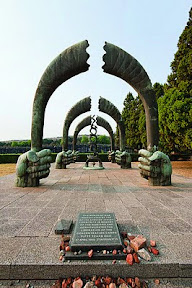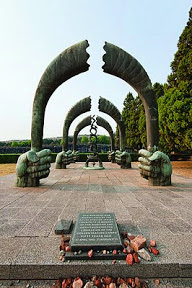 |
| ‘Monument to the Six Million’ at Westpark cemetery in Johannesburg. |
Many South Africans will be familiar with the work of the Jewish, Hungarian-born sculptor Herman Wald (1906 — 1970), even if they might not have ever heard of him.
His iconic Impala Fountain, a memorial to Ernest Oppenheimer, is a popular monument of the Johannesburg CBD; his impressive Diamond Digger fountain in Kimberley is yet another. For Jewish Johannesburgers, Wald’s sculptural endeavours have long been a presence in their lives, with his huge beaten copper wings framing the Ark of the Berea Shul and his Holocaust memorial in the Westpark cemetery. While Wald’s reputation seems to rest on these public commissions, his many other smaller works in sculpture have been apparently forgotten, or at least neglected by the mainstream historians of South African art.
The neglect of Wald’s work might have had much to do with the fact that he worked in a bewildering range of forms, styles and media, and that he was deemed an inconsistent ‘commercial’ sculptor and not a ‘professional’ one according to the criteria of having one’s work acquired by public art galleries or attaining a teaching post in a tertiary fine arts institution. Wald’s work is not found in any South African public art collection, and he never taught formally. Yet he managed to establish a full-time career for himself as a sculptor, and played an important role as a mentor to other aspirant sculptors.
Steeped in Jewish tradition
Wald’s work is diverse both stylistically and thematically, revealing his knowledge of, and exposure to a variety of modern movements and styles which he absorbed as a student in Budapest, Vienna, Berlin, Paris and London. His difficulty, perhaps, was adapting these influences and making compromises to suit the demands of the South African audiences and patrons upon whom he depended for his livelihood. The son of a rabbi, and steeped in Jewish tradition, Wald sought patronage from the Johannesburg Jewish community and produced many works on Biblical and spiritual themes. Of interest is the challenge he took up as a sculptor in relation to the prohibition of the Second Commandment, and the reception of his work by Jewish audiences. While Wald’s major public works have survived, much of his other work was either left in his studio, sold, lost or even destroyed over the years. However, largely thanks to the efforts of his late wife Vera, who documented his work and career assiduously, there is a good record of what he achieved. The retrieval of Wald’s legacy has become a family mission, largely driven by his sons Louis and Michael. Louis created a highly-detailed online database of his father’s work and has also been instrumental in working with Wits University in setting up two impressive casts of bronzes by Wald on their campus.
The powerful centrepiece which will greet visitors to the exhibition on Wald at the SA Jewish Museum will be his Wings of the Shechinah, which will be shown in the appropriate setting of the Gardens Shul. The exhibition itself will be entitled Wings of the Shechinah: The Art of Herman Wald. Made of beaten metal, the Wings are a modern equivalent to the inspirational work of the ancient Jewish sculptors who made furnishings for the Ark of the Covenant and the Temple of Solomon. Embracing the Ark in which the Law is carried, as Wald himself said; “the aim is to give the impression that the message they carry is floating across the whole world”.
On show will be over 50 sculptures — three on a monumental scale, over 60 sketches, writings and an array of audiovisual displays.











